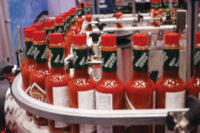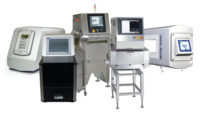Vision and inspection/ detection machinery aids in packaging line production.
Overcoming obstacles

Checkweigher models that target dry products are easy to integrate into operations that already run wet products.

The Videojet VCIS has been specifically designed to verify inkjet-printed codes on consumer packaging.


In today’s changing packaging landscape, challenges and obstacles are sure to appear for packagers and suppliers meeting new industry standards, as well as satisfying consumer demand. New machinery and technology in the inspection, detection and vision space rise to the challenge to overcome these obstacles and provide unmatched efficiency. We talked with Sam Lopez, director of sales and marketing at Matrox Imaging about major challenges customers face when dealing with inspection technology.
“Whether customers are integrating inspection technology themselves, outsourcing it to integrators or bringing in ready-made inspection systems, there are a few key challenges they face. Cost-benefit: Firstly, machine inspection replaces labor with the intention to offer a standardized, non-variable inspection process. In certain situations and locales, workers performing inspections may be more economically feasible, even if the technology is more reliable. Great technology needs to be scoped, designed and priced to take this into account,” says Lopez.
For dry goods application, there is a new checkweigher available that boasts a decreasing total cost of ownership and improved accuracy, while decreasing product giveaway. Added to the Thermo Fisher Scientific Versa platform (thermofisher.com), are the Versa Flex (fixed height) and Versa Flex GP (height-adjustable cantilever) checkweighers.
The line targets dry applications across several industries such as baked goods, snack foods, prepared foods, pastas/rice/beans and baking ingredients to personal care products such as diapers, soaps and creams, as well as pharmaceuticals.
“We developed the Versa Flex models to make precision checkweighing more affordable for companies that previously couldn’t justify the expenditure,” says Rick Cash, product manager, checkweighers, Thermo Fisher Scientific.
An added bonus is that checkweigher models that target dry products are easy to integrate into operations that already run wet products. Because the entire Versa line shares a large percentage of common parts and maintenance procedures, companies can benefit from deploying the platform throughout the plant.
The Versa Flex and Versa Flex GP checkweighers offer easy-to-read touch screens with multiple language options. Frames have been designed to minimize food build-up, and rapid-release conveyors and belts also help simplify maintenance.
In addition to cost benefit trials, customers face challenges with efficiency and traceability for sensitive products.
“Inspection needs to be consistent, no matter what the variations are. This is tough, as you need to design with a representative set of samples – but it’s not always possible to anticipate the variability. Traceability: Of particular note in pharmaceuticals and food & beverage, the ability to record and archive inspections for regulatory reasons is incredibly important and this requirement is gaining more and more momentum,” continues Lopez.
Overcoming vision impairments
To overcome the challenges of using inkjet-printed, dot-matrix text in vision inspection applications, Matrox® Imaging (matrox.com) introduces Matrox SureDotOCR™. Particularly suited for packaging lines in the food, beverage, pharmaceutical and healthcare sectors, it is an easy-to-use solution to this problem. Existing solutions for reading dot-matrix product identification information such as manufacturing date, expiration date, lot size and product number are limited because they involve case-specific image pre-processing to form solid-stroked text prior to using traditional OCR (optical character recognition).
SureDotOCR requires simply specifying the expected dot size and dimensions of a box framing the entire text of interest. Why is this an advantage? The software can handle non-uniform dot spacing; deformed, skewed and touching characters; rotated text strings; varying contrast; uneven backgrounds and other anomalies. SureDotOCR also accepts grammar rules such as letter only, digit only, specific letter(s), specific digit(s), specific punctuation mark(s) and other designations at each character position to further enhance reading accuracy. SureDotOCR lets users define the expected dot-matrix character font but also includes predefined fonts.
SureDotOCR is available as an add-on to Matrox Imaging Library (MIL) machine vision software and is licensed with MIL’s proven solid-stroke String Reader OCR tool at no additional cost. SureDotOCR is also integrated in the recently released Design Assistant 5 flowchart-based vision software.
To meet manufacturers’ needs for automated visual code inspection that minimizes false rejects commonly found with standard OCR systems, Videojet Technologies (videojet.com) introduces the Visual Code Inspection System (VCIS) to help manufacturers confirm code quality and reduce waste associated with rejected, though readable, codes.
The Videojet VCIS has been specifically designed to verify inkjet-printed codes on consumer packaging. This technology for continuous inkjet applications can replace typical vision systems that can often pose complexity challenges and functionality trade-offs.
The high standard of typical vision systems can often cause them to fail codes that have minor imperfections or codes without visible flaws to the human eye. Even with available tolerance adjustments, false rejections can occur and negatively affect packaging line throughput. Videojet VCIS addresses the challenges of verifying machine-readable and alphanumeric codes on consumer goods packaging.
Proprietary to the Videojet VCIS, the Videojet Code Quality Trend™ (CQT) algorithm can filter out random decodability issues common with OCR systems, while still alerting users to deteriorations in print quality. Instead of passing judgment on every single code, the CQT independently analyzes the readability of each character of a code and accumulates data over multiple samples. This approach provides a solution that is statistically more likely to filter out basic decodability issues, but still pick up a negative trend in print quality.
Vision and inspection machinery must only add to production capabilities
A final takeaway when discussing adding inspection and detection machinery to a packaging line is to remember the purpose. Lopez says that customers are looking for inspection machinery to accelerate the inspection process, but that is not always the case.
“Customers across a broad number of industries are eying machine inspection systems to expedite and standardize inspection processes, however, the automation of inspection cannot be disruptive to the production process; components can’t fundamentally change how the line works. For example, inspection needs to keep pace with production rates. The hope is to increase the speed of verification; however if image capture and processing requires the line’s speed to be reduced, the value of machine inspection is not just lost, it’s a detriment,” concludes Lopez.
Advancements in the segment are here to ensure that production is not halted, but instead improved with speed and efficiency.
Looking for a reprint of this article?
From high-res PDFs to custom plaques, order your copy today!









